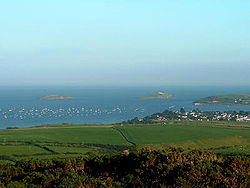Llŷn Peninsula



The Llŷn Peninsula (Welsh: Penrhyn Llŷn) extends thirty miles into the Irish Sea from north west Wales, southwest of the island of Anglesey. It is part of the modern county and historic region of Gwynedd. The name is thought to be of Irish origin, and to have the same root — Laighin in modern Irish — as the word Leinster. To English speakers, the name was formerly, and is still occasionally, spelled as Lleyn Peninsula.
Historically, the peninsula was used by pilgrims en route to Bardsey Island (Welsh Ynys Enlli), and its relative isolation has helped to conserve the Welsh language and culture, for which the locality is now famous. This perceived remoteness from urban life has lent the area an unspoilt image which has made Llŷn a popular destination for both tourists and holiday home owners, although holiday homes remains a bone of contention among locals forced out of the housing market by incomers. In the 1970s, 80s and 90s, shadowy terrorist group Meibion Glyndŵr launched a number of arson attacks on holiday homes using incendiary devices.
Tân yn Llŷn 1936
Concern for the Welsh language was ignited in 1936 when the UK government settled on establishing a bombing school at Penyberth on the Peninsula. The events surrounding the protest became known as Tân yn Llŷn (Fire in Llŷn).[1] The UK government settled on Llŷn as the site for its new bombing school after similar locations Northumberland and Dorset were met with protests.[2]
However, UK Prime Minister Stanley Baldwin refused to hear the case against the bombing school in Wales, despite a deputation representing half a million Welsh protesters[3]. Protest against the bombing school was summed up by Saunders Lewis when he wrote that the UK government was intent upon turning one of the 'essential homes of Welsh culture, idiom, and literature' into a place for promoting a barbaric method of warfare.[4]
On 8 September 1936 the bombing school building was set on fire and in the investigations which followed Saunders Lewis, Lewis Valentine, and D.J. Williams claimed responsibility. [5] The trial at Caernarfon failed to agree on a verdict and the case was sent to the Old Bailey in London. The "Three" were sentenced to nine months' imprisonment in Wormwood Scrubs, and on their release they were greeted as heroes by fifteen thousand Welsh at a pavilion in Caernarfon.[6]
2001 census and housing
According to the 2001 census the number of Welsh speakers in Wales increased for the first time in over 100 years, with 20.5% in a population of over 2.9 million claiming fluency in Welsh, or one in five. [7] Additionally, 28% of the population of Wales claimed to understand Welsh. [8] However, the number of Welsh speakers declined in Gwynedd from 72.1% in 1991 to 68.7% in 2001.[9]
The decline in Welsh speakers in Gwynedd may be attributable to non Welsh speaking residents moving to North Wales, driving up property rates above what local Welsh speakers may afford, according to former Gwynedd county councilor Seimon Glyn of Plaid Cymru, whose controversial comments in 2001 focused attention on the issue.[10] Glyn was commenting on a report underscoring the problem of rocketing house prices outstripping what locals could pay, with the report warning that '...traditional Welsh communities could die out..." as a consequence.[11]
Much of the rural Welsh property market was driven by buyers looking for second homes for use as holiday homes, or for retirement. Many buyers were drawn to Wales from England because of relatively inexpensive house prices in Wales as compared to house prices in England.[12][13] The rise in home prices outpaced the average earnings income in Wales and meant that many local people could not afford to purchase their first home.[13]
In 2001 nearly a third of all properties in Gwynedd were bought by buyers from out of the county, and with some communities reporting as many as a third of local homes used as holiday homes.[14][15] Holiday home owners spend less then six months of the year in the local community.
The issue of locals being priced out of the local housing market is common to many rural communities throughout Britain, but in Wales the added dimension of language further complicated the issue, as many new residents did not learn the Welsh language,[14][16] [17][18] and in 1996 there had been large protests, backed by Cymdeithas yr Iaith Gymraeg, against the construction of 800 houses at Morfa Bychan near Porthmadog. [19]
Concerned for the Welsh language under these pressures, Glyn said "Once you have more than 50% of anybody living in a community that speaks a foreign language, then you lose your indigenous tongue almost immediately".[20]
Plaid Cymru had long advocated controls on second homes, and a 2001 task force headed by Dafydd Wigley recommended land should be allocated for affordable local housing, and called for grants for locals to buy houses, and recommended council tax on holiday homes should double, following similar measures in the Scottish Highlands.[15][16][20]
However the Welsh Labour-Liberal Democrat Assembly coalition rebuffed these proposals, with Assembly housing spokesman Peter Black stating that "we [can not] frame our planning laws around the Welsh language", adding "Nor can we take punitive measures against second home owners in the way that they propose as these will have an impact on the value of the homes of local people".[20]
By autumn 2001 the Exmoor National Park authority in England began consideration to limit second home ownership there which was also driving up local housing prices by as much as 31%. [17] Elfyn Llwyd, Plaid Cymru's Parliamentary Group Leader, said that the issues in Exmoor National Park were the same as in Wales, however in Wales there is the added dimension of language and culture.[17]
Reflecting on the controversy Glyn's comments caused earlier in the year, Llwyd observed "What is interesting is of course it is fine for Exmoor to defend their community but in Wales when you try to say these things it is called racist..."[17]
Llwyd called on other parties to join in a debate to bring the Exmoor experience to Wales when he said "... I really do ask them and I plead with them to come around the table and talk about the Exmoor suggestion and see if we can now bring it into Wales".[17]
By spring 2002 both the Snowdonia National Park (Welsh: Parc Cenedlaethol Eryri) and Pembrokeshire Coast National Park (Welsh: Parc Cenedlaethol Arfordir Penfro) authorities began limiting second home ownership within the parks, following the example set by Exmoor.[21] According to planners in Snowdonia and Pembroke applicants for new homes must demonstrate a proven local need or the applicant had strong links with the area.
By 2003 however, a survey of schools showed that just over 94% of children between 3 and 15 were able to speak Welsh, making Llŷn one of the foremost heartlands for the language, though — as with the rest of Northwest Wales — there have been concerns that the influx of English speakers are damaging the standing of Welsh.
Geographic notability
Geographically, Llŷn is notable for its large number of protected sites — including a National Nature Reserve at Cors Geirch, a National Heritage Coastline and a European Marine Special Area of Conservation as well as twenty Sites of Special Scientific Interest. Much of the coastline and the ex-volcanic hills are part of the Llŷn Area of Outstanding Natural Beauty (AONB), confirming the peninsula as one of the most scientifically important in both Wales and Britain. The Llŷn Coastal Path long distance footpath enables walkers to fully explore both coasts of the peninsula.
Settlements
Settlements on the Llŷn peninsula include:
- Aberdaron
- Abersoch
- Botwnnog
- Criccieth
- Llanaelhaearn
- Llanbedrog
- Llanengan
- Llangian
- Morfa Nefyn
- Mynytho
- Nefyn
- Penyberth
- Porthdinllaen
- Porthmadog
- Pwllheli — considered the unofficial "capital" of the area
- Rhiw
- Sarn Meyllteyrn
- Trefor
- Tudweiliog
Hills
Hills in Llŷn include:
On 19 July 1984 there was an earthquake beneath the peninsula. It measured 5.4 on the Richter Scale and was felt in many parts of Ireland and western Britain; see 1984 Llŷn Peninsula earthquake.
The Welsh Language and Heritage Centre of Nant Gwrtheyrn is situated on the north coast.
References
- ^ John Davies, A History of Wales, Penguin, 1994, ISBN 0-14-014581-8, page 593
- ^ Davies, op cit, page 592
- ^ Davies, op cit, page 592
- ^ Davies, op cit, page 592
- ^ Davies, op cit, page 592
- ^ Davies, op cit, page 592
- ^ Census shows Welsh language rise Friday, 14 February, 2003 extracted 12-04-07
- ^ Census shows Welsh language rise Friday, 14 February, 2003 extracted 12-04-07
- ^ Census shows Welsh language rise Friday, 14 February, 2003 extracted 12-04-07
- ^ Plaid bids to defuse 'racism' row, BBC Wales, 21 February, 2001
- ^ 'Racist' remarks lost Plaid votes, BBC Wales, 3 September, 2001
- ^ Property prices in England and Wales Wednesday, 8 August, 2001, extracted 24 Jan 2008
- ^ a b House prices outpacing incomes Monday, 3 December, 2001, extracted 24 Jan 2008
- ^ a b Apology over 'insults' to English, BBC Wales, 3 September, 2001
- ^ a b UK: Wales Plaid calls for second home controls, BBC Wales, November 17, 1999
- ^ a b Double tax for holiday home owners Thursday, 16 December, 1999, extracted 24 Jan 2008
- ^ a b c d e Controls on second homes reviewed Wednesday, 5 September, 2001 extracted 24 Jan 2008
- ^ Gwynedd considers holiday home curb Tuesday, 9 April, 2002, extracted 24 Jan 2008
- ^
See e.g. Remember 1996, BBC Cymru (in Welsh, extracted 1 Feb 2008).
The protests followed a High Court decision that planning permission given in 1964 was still valid, which Cymdeithas yr Iaith Gymraeg described as a "scandal" in a 1998 report — Dewch gyda ni! (Come with us!), (extracted 1 Feb 2008).
The owners of the site later entered a legal agreement with the council which allowed building of a caravan site on part of the site, but which set aside the earlier permission for the houses; the council later also settled a compensation claim by the developers for its handling of the matter; see 25 year legal case ends as Welsh council pay £1.9 million, NewsWales (extracted 1 Feb 2008) - ^ a b c Plaid plan 'protects' rural areas, BBC Wales, 19 June, 2001
- ^ Park to ban new holiday homes Wednesday, 6 March, 2002 extracted 24 Jan 2008
Further reading
- The Lleyn Peninsula Coastal Path, John Cantrell. Cicerone 2006 ISBN 978 1 85284 479 0
External links
- Lluniau PenLlyn Photography - Photographs of the Llŷn Peninsula
- Penllyn.com - Information sites for the communities of Llŷn
- Llyn.info - Your online guide to the Llŷn Peninsula
- A comparative study of two agri-environmental schemes in cherished landscapes
- LlŷnWiki
- Llŷn Weather
- [1]This site offers numerous old postcard views of the area, as well as some excellent aerial views.

